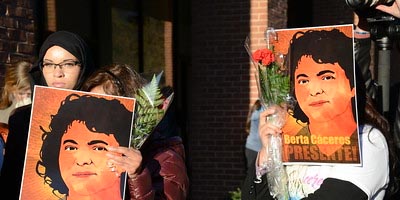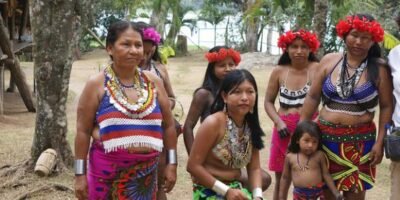On October 11th Arnulfo Cerón Soriano disappeared after leaving his home in La Montaña, Guerrero, Mexico. A lawyer and human rights defender of Naua descent, he had been actively involved in community organization to protect indigenous rights. As the leader of the Popular Front of the Mountain, he offered legal advice to indigenous and peasant merchants and acted as an intermediary with local, state, and federal authorities. After his disappearance, his family and colleagues received several threatening phone calls, in which his daughters’ names were mentioned. After weeks of his family and human rights organizations pressuring authorities to search for him, his body was found on November 20th, buried under nearly three meters of soil.
Arnulfo Cerón Soriano was only one of hundreds of activists targeted and murdered this year. With development projects being imposed more forcefully than ever in Latin America, particularly in indigenous communities, development financiers who fund these projects too often play an injurious role in the persecution of human rights defenders. Physical distance from the projects that they fund, cooperation with corrupt governments and a lack of meaningful consultation mean that development financiers often face fierce local opposition from human rights defenders that may be improperly unaddressed or altogether ignored, and an increasing number of defenders pay for their activism with their lives.
Latin America: A Hotbed for Activism
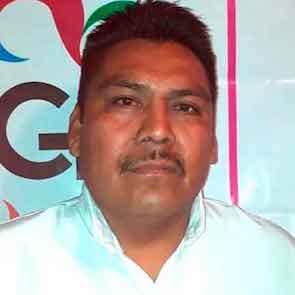
Indigenous lawyer and human rights defender Arnulfo Cerón Soriano, whose body was found on November 20th after he’d been targeted for his work in community organization. Photo Source: Front Line Defenders.
The current development model of Latin America promotes economic growth over other dimensions of development, such as environmental sustainability, equity, social justice and respect for human rights. Companies and development finance institutions consequently pressure the state to open up territory to natural resource extraction and large development projects, putting fragile environments and vulnerable people at risk.
Manuel Balán, a professor of Political Science and International Development Studies at McGill University, explained that governments in Latin America are eager to bolster their economies. “The goal is to attract investment, and that investment is particularly directed towards the exploitation of natural resources, which undermines the livelihoods of the people who live in those places.”
Profound inequalities mean that certain groups are doubly at risk of persecution, like women and LGBTQ defenders. Indigenous defenders in particular are often most vulnerable, said Sandra Patargo, the Protection Coordinator for the Americas at Front Line Defenders. “We have different kinds of attacks against human rights defenders, like LGBTI and reproductive rights activists,” she said. “But the most targeted, vulnerable groups we meet are specifically defending land, environment and indigenous peoples’ rights.”
What’s Happening on the Ground: Attacks, Murders, and Money
It rarely starts with outright murder, said Patargo. “These kinds of attacks always start with the communities, groups, organizations, or even individuals being labeled as anti-development.” Patargo explained that attacks against human rights defenders usually begin with a smear campaign, then branch off into different kinds of threats: “it can be a local campaign, where part of the community is actually supporting the project; or, it has happened as well that companies pay for spaces in media outlets to help make smear campaigns bigger and reach a bigger audience.” Afterwards, a smear campaign can prompt harassment, intimidation, physical threats, and finally, murder.
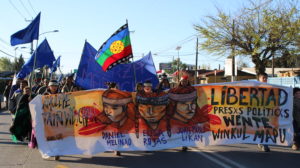
Marcha Mapuche in Angol, Chile, where the Mapuche community has been criminalized and attacked with anti-terrorism laws for opposing resource extraction exploitation. Photo Source: Carpintero Libre, Flickr.
Criminalization is also a tool actively used to persecute human rights defenders. Detention, Patargo said, is “something that happens very often.” If an activist suddenly gets arrested or imprisoned on trumped-up charges, it can take years to take care of the ensuing legal battle. When facing ongoing detention, exorbitant legal fees, or drawn-out cases, an HRD will have little time to continue opposing the development project they were fighting against.
Balán explained the role that criminalization plays in defeating opposition against development projects. “There is a deployment of the legal apparatus of the state in order to fight those who oppose the goals of certain individuals within the state. In Chile, what you see is that the Mapuche communities that have opposed certain measures of resource extraction were targeted using anti-terrorism law.” he said. “The rhetoric is not that the government is subverting the law, but that they’re using the law to advance public good. That public good isn’t necessarily an inclusive and human-rights oriented type of public good when it comes to development projects.”
With rural communities dealing with the brunt of the imposition of development projects, attacks against defenders mostly go unrecorded, as the presence of the state is limited, and defenders do not have access to all their rights.
“The most grassroots defenders are the ones doing the fighting,” said Patargo. “At the same time, they are the ones that have less recognition, in the sense that when indigenous defenders are killed, no one is really paying attention about these individual cases.”
Tracing attacks back directly to a development financier further complicates things; more often than not, they will issue a loan or fund to a smaller, local corporation – despite local protests and even ongoing violence – and this smaller corporation will be the one to oversee the development project. “These financial institutions are very disconnected from reality, and they are actually putting money into contexts where they are sometimes not aware of the risks, not aware of local processes, or imposing development activities without consent or the meaningful consultation of these local communities,” said Patargo.
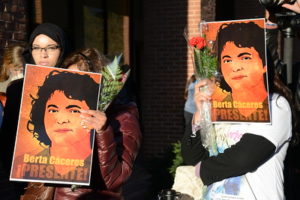
Protestors in Honduras demanding justice for the murder of indigenous leader and activist Berta Cáceres. Photo source: Daniel Cima, Flickr.
For example, following the murder of Honduran Indigenous leader Berta Cáceres in 2016, a panel was commissioned to investigate her death. It was later uncovered that DESA, the dam developer whose project she was opposing, had used its finances to commit acts of violence against people protesting the project. After receiving a USD $24 million loan from the Central American Bank for Economic Integration (CABEI), DESA used project funds to, among other things, hire informants and contract killers to neutralize those who opposed the project. Though it remains unclear whether CABEI ever officially withdrew support for the project, they reported in June 2017 – over a year after Cáceres’ death, as well as the murder of another activist, Nelson García – that loan payments had ceased.
The situation does not end with the death of a human rights defender; impunity is another contributor to systemic persecution, among development financiers and governments alike. “Sometimes what happens when human rights defenders are attacked in a context of development projects is that we only look at what’s literally on the ground,” Patargo explained, “but we’re not following the money. We’re not looking at the whole chain of people and organizations and institutions that are responsible for what happens.”
In 2014, when Dutch development bank FMO and Finnish bank FinnFund began investing in DESA, they would not exit the project for another three years, despite ongoing protests against the dam and the murders of several activists. Even when that exit time did come, they simply thanked DESA for its “willingness to put the project on hold,” and left Honduras without another word.
Impunity, Patargo says, is like a “blank cheque for governments and companies” to continue committing human rights abuses, especially as they go undocumented. “That’s why it’s so important, in cases like Berta Cáceres, to reach complete justice and responsibility for everyone involved. Otherwise, it’s just a show.”
“The Deadliest Region in the World”
With climate change becoming an increasingly intractable problem, there is increasing pressure on development financiers to fund and promote projects that are not only beneficial for local communities, but sustainable for the environment. In Latin America, where resource exploitation is an ongoing issue, the situation has become riskier for human rights defenders who are calling on development financiers to reevaluate their conduct and promote green activities.
Global Witness reported that 164 environmental activists were killed worldwide in 2018, with just over half coming from Latin America alone, mainly because of the region’s longstanding tradition of activism. Guatemala experienced a fivefold surge in killings – from three environmental activists murdered in 2017, to sixteen being killed the following year.
Because climate change disproportionately affects indigenous lands and peoples, indigenous human rights defenders are at an even higher risk. “It’s important to say that we do believe that the attacks against land, environmental, and indigenous defenders have increased; general attacks against human rights defenders have increased. In 2018 we documented the killing of 321 defenders in 27 countries. This is the highest number we have ever recorded,” said Patargo.
“I think some indigenous leaders don’t even see themselves as fighting against climate change. But without even realizing, they are at the frontlines of the battle against climate change,” Patargo said.
In Brazil, groups like the Quilombola (Afro-Descent) and the Kaiowà suffer the worst persecution, like Kaiowà defender Marinalva Manoel, who was killed for disputing developers’ claims to indigenous land intended for urban development. In Honduras, activists like Tolupán leader José de los Santos Sevilla, who was killed in 2017 for opposing excessive resource extraction, face threats and criminalization when defending environmental rights.
Patargo pointed to the specific danger indigenous environmental leaders face: “They are leading this fight and doing amazing work, and at the same time, they are the most vulnerable and attacked of these environmental groups, specifically the ones that are in communities working at a very grassroots level.”
Accountability through Policy Reform
In the last ten years, there has been a wave of policy framework reform intended to amplify Indigenous voices in development projects and mitigate the social instability that prompts human rights defenders to react. Institutions like the Inter-American Development Bank (IDB) are taking steps to improve their accountability towards human rights defenders, with their updated E&S Safeguard Policies due to be completed by 2020 and implemented in 2021. Following the Jam vs. IFC ruling, IFC CEO Philippe Le Houérou announced changes to their E&S framework that involved vetting high-risk projects and increasing E&S staff. *
Gretchen Gordon, coordinator at the Coalition for Human Rights in Development, spoke about the coalition’s ongoing work with the IDB: “We have been engaged for a while in pressing the IDB on human rights and human rights defenders. It is a good moment for them to make some improvement.”
Free, Prior and Informed Consent (FPIC) has become a staple of any development project that may affect indigenous peoples. When I spoke to Gordon, she emphasized its role in the dynamic between development financiers and indigenous peoples: “it’s part of their self-determination and land rights, their existence, and all these other things that you see when you are imposing projects on people that can cause human rights problems down the line.”
The belief is that meaningful and ongoing consultation with the groups who will be most affected by development projects will reduce the likelihood of protests and improve upon sustainable development.
Balán explained the mainstream tactic: “You have the approach that many corporations have taken, which is Corporate Social Responsibility. Thinking about the impacts on local communities, and trying to offset their impact by creating schools, or hospitals, things like that.
“I think the difference here is between development projects that are completely unregulated and do absolutely nothing, and development projects that give back something to the community, where they leave part of their assets in the country long term, where they’re taxed, where those funds are reinvested and redistributed in social policies. That, in a sense is a the least bad or best case scenario.”
Policy Reform – Is It Enough?
Though international finance institutions are taking steps to mitigate negative impacts, policy reform may be insufficient, and development financiers may be doing more harm than good, Balán says. “To me, this is not a technical issue insofar as design, it’s more about the political will. What these mechanisms entail is some sort of fragmentation within indigenous communities, and by offering goodies to the people who support a project, you end up breaking those communities.”
According to the IDB’s Modernization of the Environmental and Social Policies, the IFC’s Performance Standards – implemented in 2006 and updated in 2012 – represent the most widely adopted and used international benchmarks for environmental and social risk management. The Coalition for Human Rights Defenders reports in Uncalculated Risks, a report on development financiers’ impact on human rights defenders around the world, that out of twenty-five case studies, the IFC had been involved in eleven development projects involving the persecution of human rights defenders.
What the Coalition calls a “key funder of problematic projects” also lays the policy framework for how other international financial institutions should be operating abroad. This is especially concerning for some with regards to the IFC’s Performance Standards regarding Indigenous peoples: “I think FPIC is a standard that is usually not met. Even when we see consent, it isn’t true consent; it’s kind of more of a rubber stamp of some kind,” said Balán.
For example, the IFC Standards report that governments often play a central role in managing indigenous peoples’ affairs and encourage their clients to cooperate with the appropriate authorities. But in places like Brazil, where indigenous people’s rights are often unmet, cooperation with the government is not always conducive to protecting human rights defenders.
Marcelo Xavier da Silva’s appointment as the president of the Funai agency (National Indian Foundation) speaks to this. Da Silva has been linked to agribusiness, and it is widely believed that President Jair Bolsonaro specifically appointed him to be able to develop indigenous lands, including protected reserves in the Amazon. Bolsonaro has also expressed explicit dislike of the Funai agency, calling them “a nest of rats” in a July 2019 tweet. This can only bode ill for Indigenous and environmental defenders in Brazil, where an estimated 70 human rights defenders were killed in 2017.
For Balán, it comes down to ideals versus the reality of implementation. “CSR, FPIC, these are all ideas that could potentially work, and when it comes to implementation, sometimes they work, and many times they don’t,” he said. “You can tweak, but in the end, there is no infallible mechanism. Of course, the better a policy is designed, the less likely it is to be abused, but it’s not a guarantee.”
Patargo spoke about the risks that arise early on in policy design: “It can happen that the staff that are part of these [accountability or E&S] mechanisms don’t have a human rights perspective, or don’t have a gendered perspective, or that they’re all white men that are trying to look at the context of indigenous communities. There’s still a very neo-colonial approach in some of these policies.”
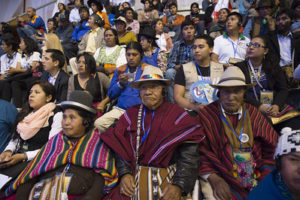
Indigenous Attendees of the People’s World Conference on Climate Change and the Defense of Life in Cochabamba, Bolivia. The event’s focus was the views of indigenous peoples in climate-oriented social movements. Photo Source: Eskinder Nebebe, UN Photos, Flickr.
“In the end, unfortunately, when it comes to certain development projects, you’re talking about a zero sum,” Balán said. “You’re talking about the technologies that we currently have to exploit natural resources in an effective, efficient way, which are simply not compatible with the interests of the communities who live in those areas. And so the solution for them is: no development projects.”
“It’s really important to keep being critical of these processes,” Patargo said. “Of course, they are very important, but we have to make sure that they’re not only there to make international organizations happy, but are actually working to protect human rights defenders.”
The Future of Human Rights Defenders
The number of murdered activists in Latin America increases every year – and that’s not including violence enacted against defenders that doesn’t end in death. “We have a lot of challenges: we have climate change, we have authoritarian governments, and a lot of scenarios that makes it really hard for human rights defenders to keep doing their work,” Patargo said.
It’s something of a vicious circle: as more human rights are rescinded globally, activism increases – leading to more human rights violations and oppression. “It’s a pretty dark moment in time right now, but the movements that we do see are encouraging,” said Gordon. “Perhaps out of that crisis there will come some greater strength in movements.”
Gordon spoke about the importance of collaboration among human rights defenders internationally. The Coalition runs a global campaign called “Defenders in Development”, which brings together defenders who’ve worked with all kinds of protection organizations and grassroots groups. “The idea is to bring all those folks together to press development financiers and their government shareholders to respect human rights and safeguard defenders, and to ensure that defenders themselves can use leverage points of development finance to decrease risks they might be facing.”
“I don’t think human rights organizations can limit themselves to judicializing their claims,” Balán said. “It’s not an easy thing to do: the power imbalance is pretty significant, and will always be pretty significant.”
But, he is not wholly skeptical: “The theory says you need to create collective action, sort of transnational networks of communities and human rights activists who come together and try to defend as a whole. That’s easier said than done, of course, but maybe that is a potential way forward.”
Patargo agrees that collective action is, for now, the way forward. “There are networks that are growing, there are new human rights defenders working together every day, with new tools, new access to information, access to new spaces,” she said. “The numbers of attacks are increasing, but at the same time, the collective resistance is growing.”
Due to scheduling issues, the IDB was unable to provide commentary for this article.
The IFC did not respond to requests for comments.
Some useful links:
https://www.frontlinedefenders.org/en/resource-publication/global-analysis-2018
https://rightsindevelopment.org/uncalculatedrisks/
https://www.frontlinedefenders.org/en/open-cases
